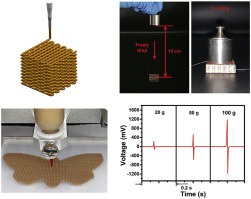Nano Energy ( IF 16.8 ) Pub Date : 2020-04-01 , DOI: 10.1016/j.nanoen.2020.104737 Zehuan Wang , Xiaoting Yuan , Jikun Yang , Yu Huan , Xiangyu Gao , Zhanmiao Li , Hong Wang , Shuxiang Dong

|
Piezoelectric ceramic materials such as Pb(Zr,Ti)O3 (PZT) based ceramics have excellent electromechanical energy conversion ability, however, their rigid and undeformed characters are not suitable for flexible electronics application. Here, we report the design of flexible (0–3) connection ceramic-polymer composite made of polydimethylsiloxane (PDMS) elastomeric matrix doped with Ag-coated PNN-PZT (0.55Pb(Ni1/3Nb2/3)O3-0.135PbZrO3-0.315PbTiO3) ceramic heterojunction particles, and the 3D printing method for fabricating complex three-dimensional grid architectures. It was found that the 3D-printing, non-stereolithographic grid-composite exhibits a greater flexible character after doping ceramic particles and also excellent electromechanical coupling with a piezoelectric voltage coefficient g33 as high as 400 × 10−3 m V N−1, which is one order of magnitude higher than that of PZT based ceramics. Under drop hammer (∼20 N) impact, it can instantly drive over 20 commercial red-LEDs lighting directly without using a charge storage capacitor. This work shows that 3D-printed flexible ceramic-polymer composite has potential to replace brittle piezoceramics for electromechanical energy conversion and touching force sensor applications, such as soft robotics, artificial muscles and biology signal identification.
中文翻译:

3D打印的柔性,Ag涂层的PNN-PZT陶瓷聚合物网格复合材料,用于机电能量转换
压电陶瓷材料,例如基于Pb(Zr,Ti)O 3(PZT)的陶瓷具有出色的机电能量转换能力,但是,它们的刚性和未变形特性不适用于柔性电子应用。这里,我们报告有Ag涂覆的PNN-PZT(0.55Pb(镍制成聚二甲基硅氧烷(PDMS)弹性体基质掺杂的柔性的(0-3)连接的陶瓷-聚合物复合材料的设计1/3的Nb 2/3)O 3 - 0.135PbZrO 3 -0.315PbTiO 3)陶瓷异质结颗粒,以及用于制造复杂的三维网格结构的3D打印方法。发现3D打印非立体平版网格复合材料在掺杂陶瓷颗粒后显示出更大的柔韧性,并且在压电电压系数g 33高达400×10 -3 m V N -1的情况下也表现出优异的机电耦合性,比基于PZT的陶瓷高一个数量级。在落锤(约20 N)的冲击下,它可以立即直接驱动20多个商业红色LED照明,而无需使用电荷存储电容器。这项工作表明3D打印的柔性陶瓷-聚合物复合材料有潜力替代脆性压电陶瓷,用于机电能量转换和接触力传感器应用,例如软机器人,人造肌肉和生物信号识别。











































 京公网安备 11010802027423号
京公网安备 11010802027423号